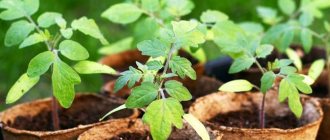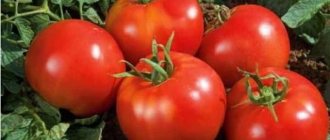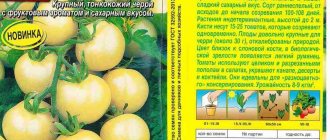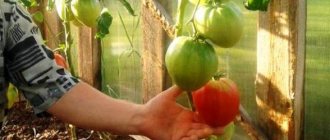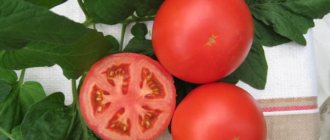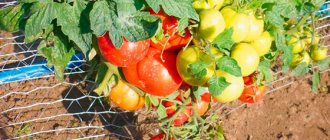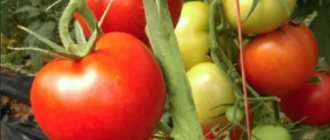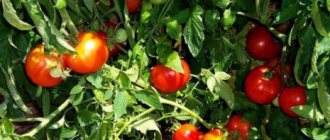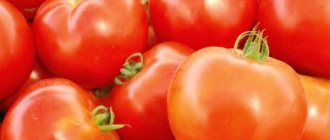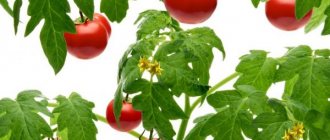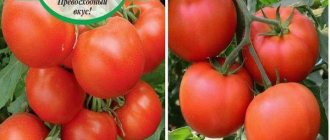Tomato Budenovka: variety description
Budenovka tomatoes are similar in plant type, shape, and taste of the fruit to the well-known and familiar to many variety, Bull's Heart.
This variety of tomatoes will give odds to any hybrid in terms of resistance to disease and general condition. Hybrids have a number of advantages, such as immunity to weather conditions and self-pollination. Their cost is much higher than varietal varieties, and the main disadvantage of hybrids is the impossibility of growing a good harvest from their seeds for the next year - they lose quality properties. The Budenovka variety is an indeterminate tomato. A plant is considered indeterminate if it does not have growth termination points. Thus, it is necessary to pinch the top. By type of bush - not standard. It has an average height, up to 120 cm, sometimes up to 150 cm, on average about 1 m . The rhizome is powerful, grows wildly more than half a meter in width. The stem is thin; tying is necessary - a weak stem will not support large fruits. There are few foliage on the stem; there are about 6-8 simple brushes.
The typically tomato leaves are dark green in color and have a medium size and a wrinkled structure without pubescence. The inflorescence is simple, intermediate - the first is formed above the 9-11th leaf, then there is a gap of 3 leaves or more. The inflorescence produces 6 large fruits. Removing several flowers (you can leave 6-8) allows the fruits to develop better.
In terms of ripening time, it is considered mid-early; fruit ripening begins on the 100th - 110th day after germination. Maturation occurs quickly and smoothly.
The variety is resistant to late blight, powdery mildew and other common diseases . It is possible to grow Budenovka tomatoes in greenhouses, open ground, and under film coverings. In open ground the plant will be smaller in size. Cultivation in open ground in warm regions of the country is recommended.
We bring to your attention useful information on the topic: How to grow a lot of tasty tomatoes in open ground? How to get excellent harvests in greenhouses all year round? What subtleties of agricultural technology of early varieties should everyone know?
Harvest tomatoes from Gavrish on video
If you grew Budenovka tomatoes, please write how you liked them. What was the yield and taste of the fruits in your climatic conditions? Will you grow them again? How do you rate the disease resistance of this tomato? Briefly describe the advantages and disadvantages of this tomato in your opinion, and evaluate its taste. If possible, attach a photo of the entire bush or individual fruits you grew to your comment. Thank you!
Your reviews of the Budenovka tomato and additions to the description will help many gardeners evaluate this variety objectively and decide whether it is worth growing or not.
This is a natural variety of tomato. Therefore, we recommend taking seeds from a ripe fruit and using them for planting in subsequent seasons.
Photo
See below: Budenovka tomatoes photo
Harvesting
Harvesting begins when the tomatoes turn brown. Tomatoes do not ripen at the same time, so harvesting lasts for 2 months.
The procedure is carried out early in the morning in dry, clear weather. Unripe tomatoes are laid out in one layer on a flat surface in a warm, bright room. After just three days, the ripe fruits are removed for long-term storage in a cool, well-ventilated room.
Characteristics
Shape: round with an elongated spout, heart-shaped, few ribbed. Some gardeners saw in the fruits the inverted shape of a Red Army soldier's headdress, which gave the variety its well-known name. Dimensions are more than 15 cm in diameter, weight is about 300 g, there are larger ones (800 g) . The skin is thin, dense, smooth. The color of unripe fruits is typically light green, while that of mature fruits is pink, sometimes darker.
You can compare the weight of the fruits of the Budenovka variety with others in the table below:
| Variety name | Fruit weight (grams) |
| Budenovka | 300 |
| Broody | 90-150 |
| Andromeda | 70-300 |
| Pink Lady | 230-280 |
| Gulliver | 200-800 |
| Banana red | 70 |
| Nastenka | 150-200 |
| Olya-la | 150-180 |
| Dubrava | 60-105 |
| Countryman | 60-80 |
| Golden Jubilee | 150-200 |
The ripeness of the fruit is noted at its palest pink color. The pulp is reddish, fleshy, soft, tasty. There are many seeds, distributed in equal parts across 4 chambers, sometimes there are more chambers. The amount of dry matter is up to 5%. The fruits are stored for a long time and tolerate transportation well . Ripening fruits are stored until November. Ripening is the harvesting of unripe fruits for further ripening. Tomatoes must be stored in a dark, dry place.
Tomato variety Budenovka is one of the types of the Siberian collection, a successful result of the State Institute of Agricultural Vegetable Crops of the Russian Federation. Registered in the State Register of the Russian Federation for cultivation in open ground, under film covers in 2002. Patented. It is permissible to grow throughout the Russian Federation.
According to the method of use - universal . Has many vitamins. The taste is sour-sweet. Suitable for fresh consumption - raw vegetable salads, sandwiches, slicing, after heat treatment - stewing, soups. They are usually preserved in crushed form as winter snacks. Suitable for the production of tomato paste and sauces, the taste will be unusually pleasant. Suitable for juice production - it turns out too thick.
It is possible to harvest a bountiful harvest from one plant - about 7 kg, which is about 20 kg per 1 sq. m . Thanks to the highly qualified breeders, the variety has no deficiencies with normal care.
You can see the yields of other varieties in the table below:
| Variety name | Productivity |
| Budenovka | 20 kg per sq.m |
| Kate | 15 kg per square meter |
| Nastenka | 10-12 kg per square meter |
| Crystal | 9.5-12 kg per square meter |
| Dubrava | 2 kg per bush |
| Red Arrow | 27 kg per square meter |
| Golden Jubilee | 15-20 kg per square meter |
| Verlioka | 5 kg per square meter |
| Diva | 8 kg per bush |
| Explosion | 3 kg per square meter |
| Golden heart | 7 kg per square meter |
Has a number of advantages:
- large fruits;
- early ripeness;
- high and long harvest;
- high percentage of resistance to diseases and pests;
- unpretentiousness;
- resistance to bad weather conditions.
Care technology
Growing the Budenovka variety will not require excessive effort from gardeners. The most time consuming is the formation of the bush and tying it up.
Watering and fertilizing
It is recommended to water the crop twice a week until the ovaries form, then less frequently. Take warm, settled water. After watering, it is recommended to loosen the soil. This will allow nutrients and air to penetrate more quickly to the roots of the plant. The first feeding of plants is carried out during the flowering period, then at the stage of ovary formation, and the last time fertilizer is applied during the period of active fruiting.
The presence of potassium and phosphorus in the soil is important for the plant, so superphosphate will be an indispensable fertilizer. In addition, compositions based on chicken droppings, wood ash, yeast, onion peels and plant infusions are suitable.
Disease and pest control
The Budenovka variety rarely gets sick, since the fruits have time to ripen before the spread of infections begins. Most often, the crop becomes infected with dry rot. For preventive purposes, tomatoes are sprayed with solutions based on drugs such as Fitosporin, Hom, Pentafag, Quadris.
“Fitoverm”, “Aktellik”, “Confidor”, “Iskra”, “Aktofit”, “Commander” will save you from the attack of whiteflies, aphids or spider mites. Dry spraying of tobacco dust or wood ash helps.
Features of cultivation
Many beginners have a fair question about how to grow the Budenovka tomato, what is its yield. There is nothing complicated in the growing process. The Budenovka tomato variety has been developed to eliminate fruit cracking (if it is not a disease). With changes in humidity and differences in night and day temperatures, the fruits begin to crack.
Seedlings are planted in mid-March for further greenhouse cultivation; when grown in open ground, they can be planted later.
The seeds are disinfected in a weak solution of potassium permanganate and soaked for several hours in a growth stimulating agent. Wash and plant in heated, disinfected soil to a depth of 2 cm in rows in a common container. The distance between plants and rows is about 2 cm.
To ensure rapid germination of plants, seeds are sometimes germinated in moist material for several days. After planting, it is necessary to water and cover with polyethylene to create the required humidity. This promotes good development. After germination, the polyethylene is removed. When 2-3 fully developed leaves are formed, picking is done in a container of about 300 ml.
Picking is carried out for better development of the roots and the plant itself. It is better to use peat or paper cups. Quickly decomposing materials will allow plants to be planted directly in glasses in a permanent place without injuring them. Hardening off the seedlings is necessary 2 weeks before transplanting. Seedlings should be planted in well-lit areas. Planting occurs in well-warmed soil in holes with fertilizer.
The planting pattern is checkerboard , the distance between plants is about 50 cm. It is necessary to immediately tie up the plants due to weak stems. The garter is suitable for trellises or individual supports. Pruning is carried out when the plant is about 50 cm high, forming a bush with one stem. Stepping is carried out once every 10 days . Watering is not needed often, at the root level. Loosening, weeding as necessary. Feed once every 2 weeks.
Methods for increasing yield
There are several ways to increase the yield of the Budenovka tomato variety:
- Timely removal of side branches that appear from the leaf axils. Stepchildren take away many nutrients that are necessary for fruit set.
- When transplanting seedlings, you need to shorten the central root to activate the growth of lateral root branches. They will provide the plant with a sufficient amount of nutritional components.
- Pruning lateral roots strengthens the entire root system and improves the growth of the above-ground part of the plant.
- Pinching the central stem of the plant promotes the development of lateral branches on which fruits are formed.
- It is recommended to remove excess leaves, which shade the plantings and take away many nutrients.
- To speed up and improve the pollination process during flowering, periodically tap the stem.
- By the end of the season, flowers that have not yet formed an ovary should be removed. They only interfere with the development of fruits.
See also
Description of the Cherry Blosem F1 tomato and agricultural technology for growing the hybrid
Read
These simple secrets will increase the number of crops.
Use of fruits
The fruits of the Budenovka tomato can be harvested at the stage of brown or pink ripening. In general, the fruit ripening period lasts from July to early autumn.
Tomatoes of the Budenovka variety are recommended to be consumed fresh - they are full of vitamins and minerals. Small tomatoes can be canned, large ones can be used for making salads and lecho. Also sometimes tomatoes are cut into pieces and frozen. They can remain fresh at the ripening stage until November.
